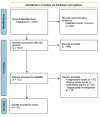Diagnostic Values of the Liver Imaging Reporting and Data System in the Detection and Characterization of Hepatocellular Carcinoma: A Systematic Review and Meta-Analysis
- PMID: 37065286
- PMCID: PMC10097431
- DOI: 10.7759/cureus.36082
Diagnostic Values of the Liver Imaging Reporting and Data System in the Detection and Characterization of Hepatocellular Carcinoma: A Systematic Review and Meta-Analysis
Abstract
This review was undertaken to assess the diagnostic value of the Liver Imaging Reporting and Data System (LI-RADS) in patients with a high risk of hepatocellular carcinoma (HCC). Google Scholar, PubMed, Web of Science, Embase, PROQUEST, and Cochrane Library, as the international databases, were searched with appropriate keywords. Using the binomial distribution formula, the variance of all studies was calculated, and using Stata version 16 (StataCorp LLC, College Station, TX, USA), the obtained data were analyzed. Using a random-effect meta-analysis approach, we determined the pooled sensitivity and specificity. Utilizing the funnel plot and Begg's and Egger's tests, we assessed publication bias. The results exhibited pooled sensitivity and pooled specificity of 0.80% and 0.89%, respectively, with a 95% confidence interval (CI) of 0.76-0.84 and 0.87-0.92, respectively. The 2018 version of LI-RADS showed the greatest sensitivity (0.83%; 95% CI 0.79-0.87; I 2 = 80.6%; P < 0.001 for heterogeneity; T 2 = 0.001). The maximum pooled specificity was detected in LI-RADS version 2014 (American College of Radiology, Reston, VA, USA; 93.0%; 95% CI 89.0-96.0; I 2 = 81.7%; P < 0.001 for heterogeneity; T 2 = 0.001). In this review, the results of estimated sensitivity and specificity were satisfactory. Therefore, this strategy can serve as an appropriate tool for identifying HCC.
Keywords: hepatocellular carcinoma; li-rads; liver imaging; meta-analysis; systematic review.
Copyright © 2023, Arian et al.
Conflict of interest statement
The authors have declared that no competing interests exist.
Figures



Similar articles
-
Evidence Supporting Diagnostic Value of Liver Imaging Reporting and Data System for CT- and MR Imaging-based Diagnosis of Hepatocellular Carcinoma: A Systematic Review and Meta-analysis.J Biomed Phys Eng. 2024 Feb 1;14(1):5-20. doi: 10.31661/jbpe.v0i0.2211-1562. eCollection 2024 Feb. J Biomed Phys Eng. 2024. PMID: 38357604 Free PMC article. Review.
-
The American College of Radiology contrast-enhanced ultrasound Liver Imaging Reporting and Data System and its modified version in diagnosing hepatocellular carcinoma via Sonazoid: a meta-analysis.Quant Imaging Med Surg. 2024 Jul 1;14(7):4555-4566. doi: 10.21037/qims-23-1459. Epub 2024 Jun 27. Quant Imaging Med Surg. 2024. PMID: 39022290 Free PMC article.
-
LI-RADS LR-5 on contrast-enhanced ultrasonography has satisfactory diagnostic specificity for hepatocellular carcinoma: a systematic review and meta-analysis.Quant Imaging Med Surg. 2023 Feb 1;13(2):957-969. doi: 10.21037/qims-22-591. Epub 2023 Jan 10. Quant Imaging Med Surg. 2023. PMID: 36819240 Free PMC article.
-
Diagnostic performance of LI-RADS for MRI and CT detection of HCC: A systematic review and diagnostic meta-analysis.Eur J Radiol. 2021 Jan;134:109404. doi: 10.1016/j.ejrad.2020.109404. Epub 2020 Dec 1. Eur J Radiol. 2021. PMID: 33276248
-
CT and MRI Liver Imaging Reporting and Data System Version 2018 for Hepatocellular Carcinoma: A Systematic Review With Meta-Analysis.J Am Coll Radiol. 2020 Oct;17(10):1199-1206. doi: 10.1016/j.jacr.2020.06.005. Epub 2020 Jul 5. J Am Coll Radiol. 2020. PMID: 32640250
Cited by
-
Assessment of LI-RADS efficacy in classification of hepatocellular carcinoma and benign liver nodules using DCE-MRI features and machine learning.Eur J Radiol Open. 2023 Oct 31;11:100535. doi: 10.1016/j.ejro.2023.100535. eCollection 2023 Dec. Eur J Radiol Open. 2023. PMID: 37964787 Free PMC article.
References
-
- TLR3 and TLR4 SNP variants in the liver disease resulting from hepatitis B virus and hepatitis C virus infection. Sghaier I, Zidi S, Mouelhi L, Ghazoueni E, Brochot E, Almawi WY, Loueslati BY. Br J Biomed Sci. 2019;76:35–41. - PubMed
-
- Hepatocellular carcinoma. Llovet JM, Burroughs A, Bruix J. Lancet. 2003;362:1907–1917. - PubMed
-
- Hepatocellular carcinoma (HCC) in non-cirrhotic liver: clinical, radiological and pathological findings. Di Martino M, Saba L, Bosco S, et al. Eur Radiol. 2014;24:1446–1454. - PubMed
Publication types
LinkOut - more resources
Full Text Sources
